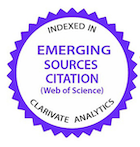FECAL EXCRETION OF Salmonella Enteritidis IN BROILER LINES ROSS AND ISA LABEL
Keywords:
Salmonella, excreções fecais, avesAbstract
The invasive capacity and persistence of this pathogen, crop and ceca in apparently healthy birds of two broiler lines raised without growth promoter antibiotics in ration and originated from eggs inoculated eggshell and in allantoidal cavity with Salmonella Enteritidis. Histological and bacteriological exams from cecal and crop were performed with one, seven, 14 and 21 days of age after hatch in broilers of fast and slow growing rate. Bacterio-logical exams were performed fecal excretion with one, eigth, 22 and 35 days. The Salmonella Enteritidis invaded and colonizated the gastrointestinal tract of the two lines tested, but the the infection reduced with age, and was more persistant in Ross broilers. The results were different for two lines. The pathogen was excreted from just one chick of ISA Label at 22 days of age and four Ross chicks until 35 days of age. In order, Salmonella was detected in 87.5% (14/16) and 38,1% (5/16) of ceca; in 81.2% (13/16) and 12.5% (2/16) of crops; in fast and slow growing rate lines, respectively. In apparent healthy organs, excepted the crop, an inflammatory process with predominance of macrophage and lymphocytes. The slow growing rate line was effective to eliminate bacteria in the organism.
Key-words: Ceca, crop, fecal excretion, inflammation.
Downloads
Downloads
Published
How to Cite
Issue
Section
License
Copyright (c) 2007 Brazilian Animal Science/ Ciência Animal Brasileira

This work is licensed under a Creative Commons Attribution 4.0 International License.
Authors who publish with this journal agree to the following terms:
- Authors retain copyright and grant the journal right of first publication with the work simultaneously licensed under a Creative Commons Attribution License that allows others to share the work with an acknowledgement of the work's authorship and initial publication in this journal.
- Authors are able to enter into separate, additional contractual arrangements for the non-exclusive distribution of the journal's published version of the work (e.g., post it to an institutional repository or publish it in a book), with an acknowledgement of its initial publication in this journal.
- Authors are permitted and encouraged to post their work online (e.g. in institutional repositories or on their website) prior to and during the submission process, as it can lead to productive exchanges, as well as earlier and greater citation of published work (See The Effect of Open Access).



























